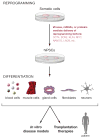Induced Pluripotent Stem Cells Meet Genome Editing
- PMID: 27152442
- PMCID: PMC4871596
- DOI: 10.1016/j.stem.2016.04.013
Induced Pluripotent Stem Cells Meet Genome Editing
Abstract
It is extremely rare for a single experiment to be so impactful and timely that it shapes and forecasts the experiments of the next decade. Here, we review how two such experiments-the generation of human induced pluripotent stem cells (iPSCs) and the development of CRISPR/Cas9 technology-have fundamentally reshaped our approach to biomedical research, stem cell biology, and human genetics. We will also highlight the previous knowledge that iPSC and CRISPR/Cas9 technologies were built on as this groundwork demonstrated the need for solutions and the benefits that these technologies provided and set the stage for their success.
Copyright © 2016 Elsevier Inc. All rights reserved.
Figures



References
-
- Avior Y, Sagi I, Benvenisty N. Pluripotent stem cells in disease modelling and drug discovery. Nature reviews Molecular cell biology. 2016;17:170–182. - PubMed
Publication types
MeSH terms
Grants and funding
LinkOut - more resources
Full Text Sources
Other Literature Sources

